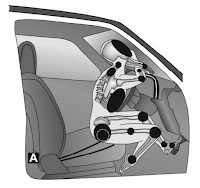Transportation Injuries in Forensic Medicine
Introduction to Transportation Injuries
These injuries are blunt force injuries that happen due to traveling on the ground, air, and water. The most common transportation injuries are motor and pedestrian injuries. Following are the various transportation injuries:
Types of Transportation Injuries
A) Vehicular Injuries
These injuries are blunt force injuries that happen due to traveling on the ground either walking and being hit by some car or simply driving a car and crashing it. Those injured by accidents can be divided into three broad groups that are pedestrians, cyclists (Pedal or motor), and the drivers/passenger of vehicles.
1. Pedestrian Injuries
(i) Primary Impact Injuries
These injuries are produced when any part of the victim first strikes the vehicle. Generally, when an adult is hit by the front of a car, the front bumper will strike the victim at about knee level. This will help to establish the position of the victim and in crime scene reconstruction.
The position of the injuries will be further modified by the fact that both feet were on the ground or one was raised, the nature of the surface of the road, and the footwear of the victim.
(ii) Secondary Impact Injuries
These injuries are produced due to an impact between the body part and the vehicle for the second time. The victim after striking against the vehicle is further scooped up/hurled up on the vehicle resulting in injuries to the other parts of the body by the same vehicle.
Here extensive abrasion, bruises, and lacerations may be seen. Compression of the chest, multiple rib fractures, fractures of the spine, and sternum may be seen.
(iii) Secondary Injuries
These injuries are produced when the victim is knocked down by the vehicle and strikes the ground.
Thus, receiving injuries from striking the ground and some objects present on the ground. Fractures of limbs, skull, ribs, etc are very common in secondary injuries.
2. Driver/occupant Injuries
After pedestrians, the driver is the most common casualty in road traffic accidents. Unbelted rear seat occupants are also at increased risk of serious injury. The driver and passenger injuries depend upon the type of impact crash. It can be:
(i) Front Impact
This happens when one car strikes another car or any other stationary object like a pole. In this type of impact, the head strikes the windshield or steering wheel.
The driver may receive fractures of the wrist, tibia, fibula, and pelvis. Further impact against steering wheel will cause fracture of forehead and skull.
(ii) Rear impact
The low-velocity rear impact is common that can cause minor injuries like neck fractures, leg fractures, etc. Whereas a high-velocity crash can deform and rupture the gas tank.
(iii) Side impact
In a side impact, the vehicle strikes another vehicle from the left or right side. The injuries caused by this can be severe as the car has a thin metal wall and no other components are present to absorb the force of impact. Injuries like V-shaped laceration, fragments of glass in wounds, cervical spine fracture, fractured ribs, contusion, and explosive tearing of lungs can be seen.
(iv) Roll-over
In this type of impact, the car may suffer severe damage but surprisingly, the occupants will receive moderate impact as the crashing of different sides of the vehicle will absorb the forces of impact. In this type of impact, there is no specific injury pattern.
3. Motorcycle and cycle Injuries
An accident that might result in minor injuries with an automobile can cause death with a motorcycle. The common causes of motorcycle accidents are alcohol, drugs, and environmental factors.
Primary injuries are common fractures of the tibia and fibula whereas secondary injuries are commonly skull, ribs, and cervical spine as well as contusions of the brain.
Pedal cycle injuries are common in India involving injuries to the head and chest. A unique injury seen among bicyclists is the stripping of the skin from the leg due to the limb being forced between the wheel spokes.
(B) Railway Injuries
Railway injuries are common in a country like India which has a wide railway network in the world and have an unmanned crossing, and open railway tracks.
When a body is hit by a train, it breaks into many pieces and is soiled by axle grease and dirt from the wheels on the track.
When passengers fall off the train, multiple injuries along with abrasion are seen.
There may be 'fail chest' along with traumatic asphyxia when the victim is crushed between the buffers of two bogies.
(C) Aircraft Injuries
Aircraft injuries are generally fatal and the chances of surviving an air crash are very less.
Immediate fire after an air crash will cause death due to burns.
The passengers may suffer leg injuries by being crushed against the seats in front.
Fractures of spines are also common, especially fracture of the thoracic spine.







